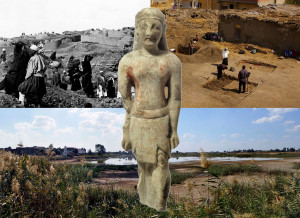
One of the most important activities of any SAS Institute is to promote and encourage cutting-edge research and to ensure that the results of projects are given the widest possible circulation among the whole research community and to a wider audience. The Naukratis Project is one example of how the Institute of Classical Studies (ICS) uses its limited funding to do just this.
Given in May 2014 by Naukratis Project members at the British Museum, led by Alexandra Villing, a curator in its Department of Greece and Rome, this lecture was highly successful. It highlighted the
Institute’s important work in publicising new research and fostering debate with implications for many different humanities topics. The Institute is collaborating with the Leverhulme Trust and the British Academy to support this international and interdisciplinary project, which involves some 70 institutions worldwide with contributions from ICS researchers.
Naukratis is a famous archaeological site in the Nile Delta, which was excavated repeatedly in the
19th and 20th centuries, most famously by Sir Flinders Petrie who rediscovered the site in 1884.
Founded in the seventh century BCE and still active into the seventh century CE, the city was an important trading port, having documented connections with 12 different Greek cities, here involved in a unique economic venture on Egyptian soil. Classical scholars have traditionally viewed the site as essentially Greek, in effect a Greek colonial settlement founded, occupied and sustained by Greek traders and settlers, perhaps even against initial Egyptian resistance.
The Naukratis Project aims to reassess this conception critically, combining the work of Classical and Egyptological historians, archaeologists and scientists. At its core is the online publication that, in the virtual space of the internet, reassembles some 20,000 finds from these earlier excavations, distributed
today between some 60 museums worldwide, where they have remained largely unstudied and unpublished. Meanwhile, extensive archival documentation of 19th-century and later excavations makes it possible to recontextualise these finds. The Project’s own new fieldwork at Naukratis is also supplying more vital clues to reconstruct the port’s history and that of its inhabitants.
The lecture showed that this combined research has unearthed quite unexpected conclusions. Far
from being an essentially Greek site, it now seems that Egyptians played an important role from the
very beginning; that there were major Egyptian as well as Greek buildings in the city; and that
many Egyptian finds have been overlooked or at least underestimated in previous work. The site’s
archaeology also demonstrates the close links that this Graeco-Egyptian settlement had with
other regions such as Cyprus and Phoenicia.
These major discoveries raise important issues not only about these cross-cultural interactions,
but also about the practices and preconceptions of scholarship in the humanities: why should
the Greek elements have been so advertised in the past and why should other elements have
been so neglected? One answer could be that 19th-century scholars regularly looked for
Greek achievements everywhere and, as a result, failed to appreciate the achievements of the
highly civilised non-Greek peoples around the Mediterranean. But, in fact rather surprisingly, a
‘Greek agenda’ was still being promoted as much, if not more, by 20th-century scholarship, as by
the 19th-century pioneers.
Research at Naukratis is set to continue, but the project is already contributing to our understanding of how ancient cultures interacted and how modern interpretations of such processes can be affected by changing scholarly perspectives. Supporting and showcasing such fresh approaches, which cross disciplinary boundaries and provoke sensitive issues, provides important opportunities for the ICS to influence research agendas, both in the UK and beyond.
This blog post was originally published in the School of Advanced Study Annual Report and Review 2014 which is available from the School in hard copy or from the SAS website (click here). For more information about the Naukratis Project check out the project pages on the British Museum website.


